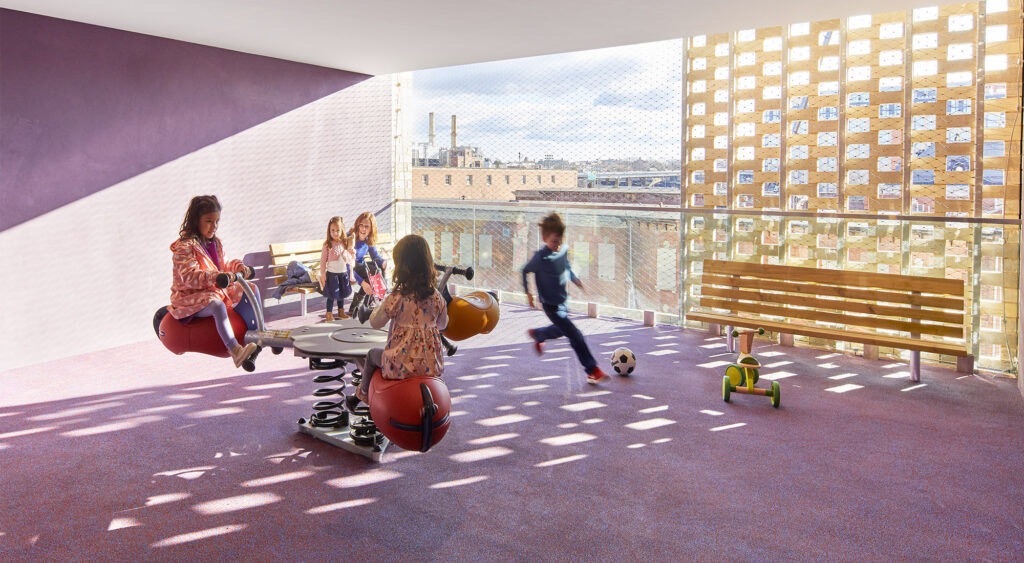The District of Columbia’s General Hospital had been an anchor institution since Thomas Jefferson’s second term until George W. Bush’s first term, and its closing in 2001 after more than 200 years sent shockwaves through the community. For one, it was the only public hospital inside the District. But, since its founding as an almshouse, it has also become a lifeline for the sick and indigent. Its final chapter, however, would not be written until 15 years after it was officially decommissioned as the de facto short-term housing option for hundreds of marginalized Washingtonians experiencing homelessness.
In 2016, Mayor Muriel Bowser launched the Homeward DC initiative to decentralize short-term housing to each of the city’s administrative wards. One of those projects, The Aya, a project by Studio Twenty Seven Architecture/Leo A Daly JV, sits on a triangular island site in Ward 6 in Southwest D.C. — a remainder in L’Enfant’s radial plan whose axis to the Capitol dome had long ago been disrupted by the Southwest Freeway. For some observers, it might have been the most unloved plot of land in Ward 6. For Studio27, however, it was brimming with potential.
“Talking with the community at the onset and trying to understand why this site and place mattered was a great way to start,” says Jake Marzolf, AIA, an associate principal at Studio 27 who led the design team. “From a design perspective, we saw the site as a great opportunity because it’s rare in D.C. with new construction to have all four sides open to light and views.”

The ground floor is carved out of a plinth, delineating community amenities and services from the residential program of the upper six floors. John K. Burke, AIA, Principal in Charge at Studio 27 who oversaw the project says that it was about more than reading the building from the outside. It was also a nod to the neighborhood’s precarious elevation only a few feet above sea level. “The buildings along the Aya’s cross-street at I Street are up on a two-foot plinth, which goes back to the area flooding every time it rained,” he says. “So, we put the building up on a plinth, too, which gave us extra height.”
The six upper levels take a ziggurat form with a tapering effect, punctuated by bump-out windows that delineate individual apartment units from the outside. Working from the outside-in, Marzolf notes that the massing steps back to accommodate the tree line down Delaware Avenue. “The geometry on the west side, with the set-backs,” he says, “offers the most private access to light and views, and that was important for residents.”
As a result, residents are offered vistas that make the interiors bright and airy. Their apartments are clustered in what Marzolf calls “neighborhoods” of no more than 10 units per floor. Each floor is self-contained for security reasons, but also to engender the kind of closeness one hopes for in a neighborhood. They each feature outdoor play areas, community rooms, and laundry facilities. The ground floor houses a medical clinic, dining room, study and exam room, and administrative areas.

The Aya was completed in 2020 and was promptly recognized by AIA Virginia and AIADC for its overall design concept and as a temporary and safe option for women and children. “This project is really for families in an emergency need and intended to be temporary. The idea is accommodating people who need help right now, and over 60 or 90 days you can move on,” says Burke.
At the ribbon cutting in February 2020, Mayor Bowser noted that, “This beautiful facility will serve as a landing spot for families that provides them with the support they need to get back to living the dignified and independent lives that they deserve.”
The real story might be the metrics, though. The Aya and the other ward projects of Homeward DC have contributed to a nearly 45 percent drop in family homelessness in the District over the last five years.
About the Project Team
Structural Engineers: Silman
MEP Engineers: Setty Associates
Civil Engineers: A. Morton Thomas & Associates, Inc.
Geotechnical Engineers: ECS Capitol Services
Cost Estimators: TCT Cost Consultants
Land Use Attorneys: Holland & Knight
Archaeologists: John Milner Associates
Acoustical Engineers: Acoustical Design Collaborative
General Contractor: Blueskye
Photographer: Anice Hoachlander/Hoachlander Davis Photography
About the Author
William Richards is a writer and editorial consultant based in Washington, D.C. From 2007 to 2011, he was the Editor-in-Chief of Inform Magazine.
